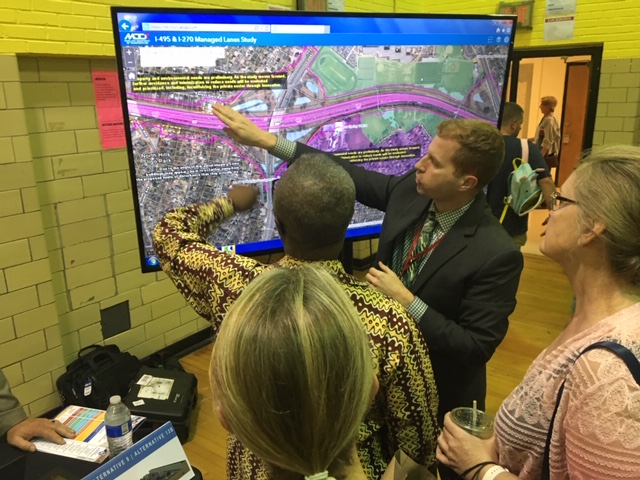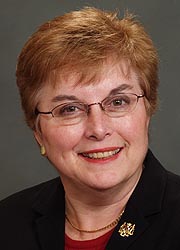Powerful Senator Is Part Cheerleader, Part Skeptic of Hogan Highway Plan

A powerful committee chairwoman whose district is at the center of a tug-of-war over transportation policy has strong feelings when it comes to a key plank of the Hogan administration’s plan to widen two crowded interstate highways.
Sen. Nancy J. King (D-Montgomery), chair of the Senate Budget and Taxation Committee, broadly supports the governor’s push to have a public-private partnership steward the widening of Interstate 270 and the Capital Beltway (I-495).
But she insists that local firms be in the driver’s seat.
“I’m very concerned about companies from outside of our region coming in to do these roads,” she said in an interview with Maryland Matters on Tuesday. “Our businesses need to flourish with any kind of growth that we have.
“Not using our people and our companies to build the roads — I just think that’s a bit of a deal breaker for me.”
In 2017, Gov. Lawrence J. Hogan Jr. (R) announced plans to widen I-270 and the Beltway two lanes in each direction. The new lanes would be funded and built by private-sector firms in exchange for the right to charge tolls on them for 50 years or more.
The companies also would agree to maintain the new and the existing lanes at their own expense.
Hogan also hopes to widen the Baltimore-Washington Parkway, which is owned by the federal government, two lanes in each direction. Negotiations to win control of that road appear to be moving slowly.
Maryland Transportation Secretary Pete K. Rahn said the governor’s proposal is borne of twin necessities — the crush of commuter traffic, which is expected to grow worse with time, and the state’s inability to fund improvements because of fiscal constraints and past borrowing.
He has also said that firms that have done complex highway projects all over the globe are eager to bring their experience and expertise to Maryland, to help the state find innovative solutions to its worst-in-the-nation traffic.
But in a statement Rahn appeared to accept King’s preference for locally based concessionaires.
“The design-build piece of these P3 projects is so large that it almost always goes to local firms,” he said.
State transportation officials are involved in something of a public feud with Montgomery’s elected leaders over the Hogan plan.
In recent days the Montgomery County Council and County Executive Marc B. Elrich (D) have requested that the county’s planning board not turn over any land to the state that it would need to widen the two roads or build new interchanges unless additional environmental and financial studies are done.
The Prince George’s County Council has adopted similar resolutions unanimously.
In a May 9 interview with Maryland Matters, Rahn accused critics of the state’s plan of “hiding from the facts” and “putting your head in the sand.”

Sen. Nancy J. King (D-Montgomery)
King, who represents much of upper Montgomery, said many of her constituents are eager to see Maryland’s road network improved, particularly 270.
“I understand where the county council and the county executive are coming from because in their mind they want to get everybody out of their cars and onto mass transit,” she said. “That’s a laudable goal, but I just don’t see it in our area. Everybody doesn’t have Metro access.
“People are desperate for a change because they’re so tired of sitting on roads.”
King said she is “really concerned” that the recent tug-of-war between local and state leaders could make it difficult to reach a consensus.
“There’s such a philosophical difference — a glaring difference — that I see out there,” she said. “I just think we have to do something. I think we’ve got to have some pretty open minds and come up with a plan. And if we need to sit down and knock heads with the [Maryland] Department of Transportation, we have to find a way to do that.”
A Washington Post poll released Sunday found that 61 percent of Washington, D.C.-area residents support Hogan’s plan. Support is strong across the region, but it dips in Prince George’s County, where concern is great that middle- and lower-income workers won’t be able to afford what critics call “Lexus lanes.”
In addition, the majority of those surveyed expressed fear that the addition of express-toll lanes will result in the taking of private homes, be too expensive to use and will not ease congestion long term.
King thinks the state is over-reliant on the P3 process and that some relief could be found at less cost than the $9 billion to $11 billion plan Hogan announced two years ago.
“There are so many things that can be done. [Maryland Route] 355 goes down to one lane going up towards Clarksburg, which is a major bottleneck. 270 going north goes down to two lanes; that’s another bottleneck. There are some things that I think could be done sooner that could bring a whole lot of relief,” she said.
King also said she understands why local leaders feel stymied in their interactions with state planners.
“I’ve talked to so many people that have tried to sit and talk with the DOT people, and they really just want to come and say, ‘This is how we’re going to do it.’ I think things could go a little easier if we had [a better] relationship, but we don’t,” she said. “I just don’t know how this turns out.”
Did someone forward this to you?
Get your own daily morning news roundup in your inbox. Free. Sign up here.




 Creative Commons Attribution
Creative Commons Attribution